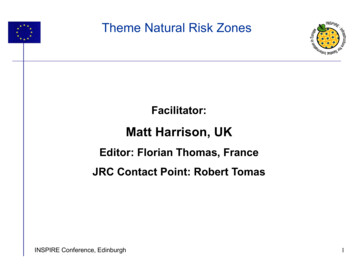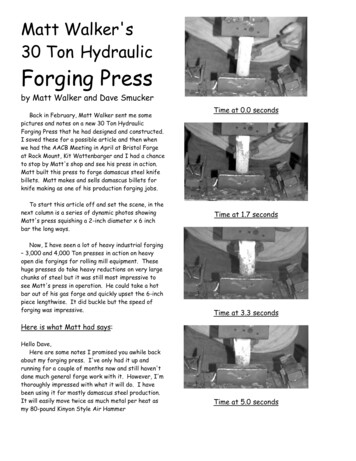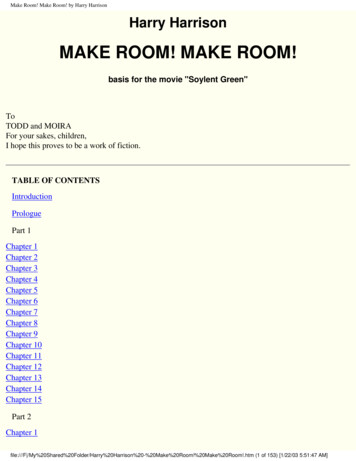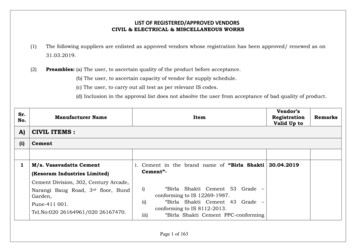
Transcription
Theme Natural Risk ZonesFacilitator:Matt Harrison, UKEditor: Florian Thomas, FranceJRC Contact Point: Robert TomasINSPIRE Conference, Edinburgh11
akarCanet sITxxxxxxxxxxxxxxxxxxx2
Presentation of the theme D2.3 Definition:«Vulnerable areas characterised according to natural hazards (all atmospheric, hydrologic,seismic, volcanic and wildfire phenomena that, because of their location, severity, andfrequency, have the potential to seriously affect society), e.g. floods, landslides andsubsidence, avalanches, forest fires, earthquakes, volcanic eruptions.»3
Input documents 32 reference documents– The Floods Directive– Work carried out by « Plan4All » Annex I : Hydrography TWG has defined an« InundatedLand » feature class4
Scope Analysis of input documents Production of use cases– « Flood » (Cross Thematic)– « Landslide »– « Forest fire»– « Earthquake » Codelist of 6 high level natural hazardcategories– 82 hazards (so far) Meeting with Floods Directive working group5
Presentation of the theme Risk is defined as:Risk hazard x exposure x vulnerability. Natural risk:– Not technological risk6
Presentation of the theme Overall philosophy:« A risk zone is the spatial intersection of a hazard area with Exposedelements some of which may have increased or lowered vulnerability tothis hazard»Hazard areaRisk zoneVulnerability AExposedelements7
Model v2.0 3 packages :– 1 core package– 1 coverage package– 1 package dedicated to flood risk Objective :– Design a generic core model to all natural risks– Apply it to all types of data (vector and coverage)– As an example, apply this core model to flood risk8
class 1 Core Mo.Model v2.0: Core voidable» determinationMethod: DeterminationMethodValue«voidable, lifeCycleInfo» validFrom: DateTime validTo: DateT ime [0.1]tagsbyValuePropertyT ype falseisCollection falsenoPropertyType falsexsdEncodingRule iso19136 2007 INSPIRE Extensions«featureT ype»RiskZone geometry: RiskHazardGeometryinspireId: IdentifiertypeOfHazard: NaturalRiskOrHazardClassification«voidable, lifeCycleInfo» beginLifespanVersion: DateTime endLifespanVersion: DateTime [0.1] source«voidable»1«voidable» levelOfHazard: LevelOfHazard likelihoodOfOccurence: LikelihoodOfOccurence result«voidable»«voidable» determinationMethod: DeterminationMethodValue legalBasis: LegislationReference [0.*] legallyBindingZone: bool0.* levelOfRisk: LevelOfRiskconstraints{A riskzone must be linked to 1 (or more) exposed elements}{legallyBindingZone - legalBasis}tagsbyValuePropertyType falseisCollection falsenoPropertyType falsexsdEncodingRule iso19136 2007 INSPIRE ExtensionstagsbyValuePropertyType falseisCollection falsenoPropertyType falsexsdEncodingRule iso19136 2007 INSPIRE Extensions sourcehazards0.*geometry: RiskHazardGeometryinspireId: IdentifiertypeOfRisk: NaturalRiskOrHazardClassification«voidable, lifeCycleInfo» beginLifespanVersion: DateTime endLifespanVersion: DateTime [0.1] validFrom: DateTime validT o: DateTime [0.1]«featureType»HazardArea riskZone«voidable» oaffects exposedElement«voidable»constraints{either the quantitative vulnerability or the quantitative vulnerability must be filled.}{If the qualitative vulnerability iscompleted, then the qualitative vulnerability assessment method must be filled.}{If the quantitative vulnerability is completed, then the quantitative vulnerability assessment method must be filled.} geometry: GM Object inspireId: Identifier typeOfElement: TypeOfExposedElementValue«voidable» nameOfEvent: CharacterString«voidable, lifeCycleInfo» validFrom: DateTime validTo: DateTime [0.1]tagsbyValuePropertyType falseisCollection falsenoPropertyT ype falsexsdEncodingRule iso19136 2007 INSPIRE Extensions1.*«voidable» qualitativeVulnerability: CharacterString qualitativeVulnerabilityAssessmentMethod: DocumentReference quantitativeVulnerability: Number quantitativeVulnerabilityAssessmentMethod: eatureType»Observ edHazardconstraints{T he likelihood of occurence is mandatory}Legal basis is to beharmonised with AMTWG0.*«voidable, lifeCycleInfo» beginLifespanVersion: DateT ime endLifespanVersion: DateTime [0.1] validFrom: DateT ime0.* validTo: DateTime [0.1]tagsbyValuePropertyType falseisCollection falsenoPropertyType falsexsdEncodingRule iso19136 2007 INSPIRE ExtensionsNOTE :An exposed element is typically any spatial object representing a realworld object or administrative/statistical unit, management are.Therefore, it is impossible to explicitly define which INSPIRE spatialobjects should be encoded as a Exposed Element.This feature class therefore aims at including any spatial data which isconsidered as an exposed element, and for which a link to a risk zone ismade, and vulnerability is calculated.9
Model v2.0: Core packageclass 2 Enumerations and codelists«dataT ype»NaturalRiskOrHazardClassification y: HazardCategoryValue«voidable» specificRiskOrHazardT ype: SpecificRiskOrHazardT ypeValue«codeList»TypeOfExposedElementValueThis codelist is empty,and is to be extendedby any data dataprovider 1 biological1 1 Epidemic1 2 InsectInfestation1 3 AnimalStampede2 geophysical2 1 Earthquake2 2 Volcano2 3 DryMassMovement3 hydrological3 1 Flood3 2 WetMassMovement4 meteorological4 1 Storm5 climatological5 1 ExtremeTemperature5 2 Drought5 3 Wildfire6 extraterrestrial6 1 Meteorite his code list is empty in the INSPIREcontext and must be extended by eachdata provider in their own codeListregister. In this register also mappingto the centralized listgenericRiskOrHazardType must beprovided«codeList»Example TypeOfExposedElement eterminationT his codelist isprovided as anexample only. It isassumed that it isincomplete.T his codelist comes from the MünichRe CRED. [Disaster Category Classificationand peril. Terminology for forOperational Purposes. ].We believe that this list has gaps. If dataproviders have a more specificclassification, this should be completed inspecificRiskOrHazardTypeValue10
Model v2.0: Coverage packageclass 3 Generic cov erag.«featureT ype»ModelledHazardCov erage«invariant»{////the record must be aqualitativeValue (from LevelOfRisk)or quantitati veValue type (fromLevelOfRisk), orriskOrHazardCategory (fromNaturalRi skOrHazardClassificati on).}«voidable» determinationMethod: DeterminationMethodValue«voidable, l ifeCycleInfo» validFrom: DateT ime validT o: DateT ime [0.1]«featureT ype»RiskCov erage«featureT ype»HazardCoverage sourceHazard0.* typeOfHazard: NaturalRiskOrHazardClassificationinspireId: Identi fier«voidable, lifeCycleInfo» beginLifespanVersion: DateT ime endLifespanVersi on: DateT ime [0.1] validFrom: DateT ime resultHazard0.* source«voidable»1 result«voidable»typeOfRisk: NaturalRiskOrHazardClassifi cationinspi reId: Identifier«voidable, l ifeCycleInfo» beginLifespanVersi on: DateT ime endLi fespanVersion: DateTime [0.1]0.* val idFrom: DateT ime val idT o: DateTi me«voidable» determinationMethod: Determinati onMethodValue legalBasis: Legisl ationReference [0.*] legall yBindingZone: Bool ean levelOfRisk: LevelOfRisk«voidable» likelihoodOfOccurence: LikelihoodOfOccurence levelOfHazard: Level OfHazard riskZone1.*«featureT ype»Coverage (Base)::Coverage«Invariant»{//the record must be aqualitativeValue (fromLevelOfHazard) orquanti tativeVal ue type (fromLevelOfHazard), orriskOrHazardCategory (fromNaturalRiskOrHazardCl assification).} VulnerabilityOfElementmetadata: Any [0.*]rangeType: RecordType«voidable» qualitativeVulnerability: CharacterString qualitativeVulnerabilityAssessmentMethod: DocumentReference quantitativeVulnerability: Number quantitativeVulnerabilityAssessmentMethod: DocumentReference exposedElement 1.*«featureT ype»ExposedElementsCov erage«featureT ype»Observ edHazardCov erage «voidable, lifeCycleInfo» validFrom: DateT ime validT o: DateT ime [0.1]«voidable» nameOfEvent: CharacterString0.*inspireId: Identifi er«voidable, l ifeCycleInfo» beginLifespanVersi on: DateT ime0.* endLi fespanVersion: DateTime [0.1] val idFrom: DateT ime val idT o: DateT ime [0.1]The Record must express the type of exposedelement. For a land-cover coverage, the recordmust be the land cover value according to aspecific classificati on11
Model v2.0 LinksHazard modellingExposed Element modellingLand useHydrologyGeologyElevationUtilities / t. Units / Pop.distributionParallelNatural risk zonesEnvironmentalmonitoring facilitiesConsequences on land use planningArea managementLand use12
f1f2Model v2.0: Core packageclass 4 xTWG links«featureT ype»EF Model V2.0RC::Env ironmentalMonitoringFacility inspireId: Identifiergeometry: GM Object [0.1]representativePoint: GM Point [0.1]name: CharacterString [0.*]additionalDescription: CharacterString [0.1]mediaMonitored: Media [0.*]typeOfMonitoring: MonitoringT ype [0.*]measurementRegime: MeasurementRegimegemetReference: ThemeValue [1.*]responsibleParty: CI ResponsibleParty [0.*]responsiblePartyRole: RoleListT ype [0.*]legalBackground: LegislationReference [0.*]mobile: MobileValueresultAcquisitionSource: ResultAcquisitionSourceValue [0.1] supersede broader0.* genealogyanyThematicLinkhierarchy supersede narrower0.*0.*byCoverage«featureT ype»2 Generic cov erages::RiskCov erage «voidable, lifeCycleInfo» beginLifespanVersion: DateT ime endLifespanVersion: DateTime [0.1]0.* validFrom: DateT ime validTo: DateT ime monitors0.*«voidable» determinationMethod: DeterminationMethodValue legalBasis: LegislationReference [0.*] legallyBindingZone: Boolean levelOfRisk: LevelOfRisk«voidable» beginLifespan: DateT ime endLifespan: DateTime [0.1] beginOperationalActivityPeriod: DateT ime endOperationalActivityPeriod: DateTime [0.1] monitorstypeOfRisk: NaturalRiskOrHazardClassificationinspireId: Identifier0.* zoningElement0.*«featureT ype»Land Use Core Model::CoreLandUseObject zoningElement0.*Recommandation :If a risk zone or a risk coverage is legally binding, then it shouldbe linked to a feature of Land-Use "CoreLandUseObject" or to aArea Management Restriction Regulation Zoes and ReportingUnits "ManagementRestrictionOrRegulationZone" areaManagement0.*0.*«featureT ype»Area Management Restriction and Regulation ureT ype»RiskZone geometry: RiskHazardGeometryinspireId: IdentifiertypeOfRisk: NaturalRiskOrHazardClassification«voidable, lifeCycleInfo» beginLifespanVersion: DateTime endLifespanVersion: DateT ime [0.1] validFrom: DateT ime validT o: DateTime [0.1]«voidable» determinationMethod: DeterminationMethodValue legalBasis: LegislationReference [0.*] legallyBindingZone: bool levelOfRisk: LevelOfRisk relatedZone0.*inspireID: IdentifierthematicID: AlternateIdentifier [0.*]name: GeographicalName [0.*]geometry: GM Object«voidable» zoneT ype: ZoneTypeCode areaManagement specialisedZoneType: SpecialisedZoneT ypeCode [0.1] validT ime: T M Period0.* competentAuthority: CI ResponsibleParty legalBasis: LegislationReference [0.1]«voidable, lifecycleInfo» beginLifespanVersion: DateT ime endLifespanVersion: DateT ime [0.1]constraints{legalBasis mandatory if not provided on SpatialDataSet level}{Geometry shall be surface or multi-surface}{Either managementInformation or controlledActivity is mandatory}13
Slide 13f1Added a new slide to complete description of the core modelfthomas, 6/15/2011f2added this one alsofthomas, 6/15/2011
Model v2.0 : Flood Package « Why floods and no other hazard? »– Flood Directive 2007/60/CE Overall idea:– Take the core model, eventually specialize it, tomake it meet Flood Directive’s requirements– Use the navigability of the links to avoidredundances, and the constraints to ensure thecoherence of the model14
Model v2.0 : Flood Packageclass Floods«dataType»FloodHazardMap inspireId: Identifier«voidable, lifeCycleInfo» beginLifespanVersion: DateTime endLifespanVersion: DateTime [0.1]«voidable» Reference: CL citationconstraints{A flood hazard map must contain one high probability prospective flooded area, one medium probability and one low probability prospective flooded area. For groundwater or seawater floods, then it is possible to fill in only one low probability potential}{For groundwater or seawater floods, then it is possible for a FloodHazardMap to fill in only one low probability potential flooded area} containsHazard area«codeList»InundationValue controlled natural sourcehazards0.* from resultHazard0.* geometry: GM MultiSurface inspireId: Identifier typeOfHazard: atureT ype»PotentialFloodedArea«voidable» classificationMethod: URI determinationMethod: DeterminationMethod levelAssessmentMethod: URI levelOfHazard: LevelOfHazard momentOfHazard: MomentOfHazard«voidable, lifeCycleInfo» beginLifespanVersion: DateTime endLifespanVersion: DateTime [0.1]constraints{Only observed hazards can be linked to vulnerable features and vulnerable zones} contains result frMap observedHazard«dataType»FloodRiskMap«voidable, lifeCycleInfo» beginLifespanVersion: DateTime hazardArea riskZone endLifespanVersion: DateTime [0.1] floodProbability: ProbabilityOfFlood geometry: GM MultiSurface inspireId: Identifierconstraints{Potential flooded areas are e geometry: GM Surface inspireId: Identifier«voidable, lifeCycleInfo» beginLifespanVersion: DateTime endLifespanVersion: DateTime [0.1] componentOflowmediumhigh fhMap11.*0.* inspireId: Identifier componentOf0.* «voidable» classificationMethod: URI determinationMethod: DeterminationMethod levelAssessmentMethod: URI levelOfRisk: LevelOfRisk1.3«voidable» reference: CL Citationconstraints{A risk cannot be observed}{A riskzone must be linked to 1 (or more) vulnerable feature or to 1 vulnerable zone} riskZone contains «voidable, lifeCycleInfo» beginLifespanVersion: DateTime0.1 endLifespanVersion: DateTime [0.1]constraints{The risk zones composing the Flood Risk Map are those derived from the potential flooded areas that are in the Flood Hazard Map which is linked to the Flood Risk Map}{The vulnerable features that are on the flood risk Map are those linked to the risk zones that are on the same flood risk Map} frMap0.*1.* dedAreaElement«featureT ype»InundatedLand«voidable, lifeCycleInfo» beginLifespanVersion: DateTime endLifespanVersion: DateTime [0.1] dateOfObservation: DateTime geometry: GM Surface inspireId: Identifier«voidable» floodFlow: int velocityOfFlow: int waterHeight: int waterlevel: int«voidable, lifeCycleInfo» beginLifespanVersion: DateTime endLifespanVersion: DateTime [0.1]Risk zone«voidable» inundationReturnPeriod: Number inundationType: InundationValueconstraints{Either water heights or water levels must be filled}{Either velocity of flow or flood flow must be filled} componentOfconstraints1.* {Inundated land is observed} origin0.* dated Land(Annex I Hydrography)«voidable» reference: CL citationconstraints{Vulnerable feature that are linked must be the ones linked to the Inundated eature vulnFeature geometry: Any inspireId: Identifier inspireId: Identifier«voidable, lifeCycleInfo» beginLifespanVersion: DateTime endLifespanVersion: DateTime [0.1] involvedFeature involvedFeature0.*0.* pFRA0.*«voidable, lifeCycleInfo» inundatedLandVulnFeature beginLifespanVersion: DateTime endLifespanVersion: DateT ime [0.1]0.*«voidable» classificationMethod: URI exposure: float exposureMethod: URI levelAssessmentMethod: URI levelOfVulnerability: LevelOfVulnerabilityExposedelement15
Model v2.0 : Flood Package New classes compared to the generic package : « Potential flooded area » : specialized from« hazard area » Flood hazard map Flood risk map Preliminary flood risk assessment « inundated land » : specialized from « hazardarea » Some concepts : The « potential adverse consequences » are« exposed elements » The « flood hazard maps » must contain 3 floodscenarios they contain 3 features from the« Potential flooded area » feat. class16
Open Questions Generic Core model- useful/ useable?More specific hazardTypes codelist?exposedElements codelist?Floods Schema– Doesn’t address detailed requirements?– Can you identify how you could extend it further?– Does it demonstrate harmony between FD and INSPIRE?More application schemas as examples?Example implementation e.g. in major GIS software?Geometry of risk zones / coverages Currently model vectordata model and coverage separatelyPortrayal rules/ guidelinesDQ & MD Chapters still require work17
Bojilov Venco x Cerba Otakar x x x x Canet Castella Raquel x x x Exadaktylos George x x x Barredo José x Harrison Matthew x x x x Pfeiffer Manuela x Thomas Florian x x Tomas Robert x x Team. 3 Presentationof the theme D2.3 Definition: «Vulnerable areas characterisedaccording to natural hazards (all atmospheric, hydrologic,

![Tenant Survival Guide[1] - The LPA](/img/17/washington-dc-tenantguide.jpg)








